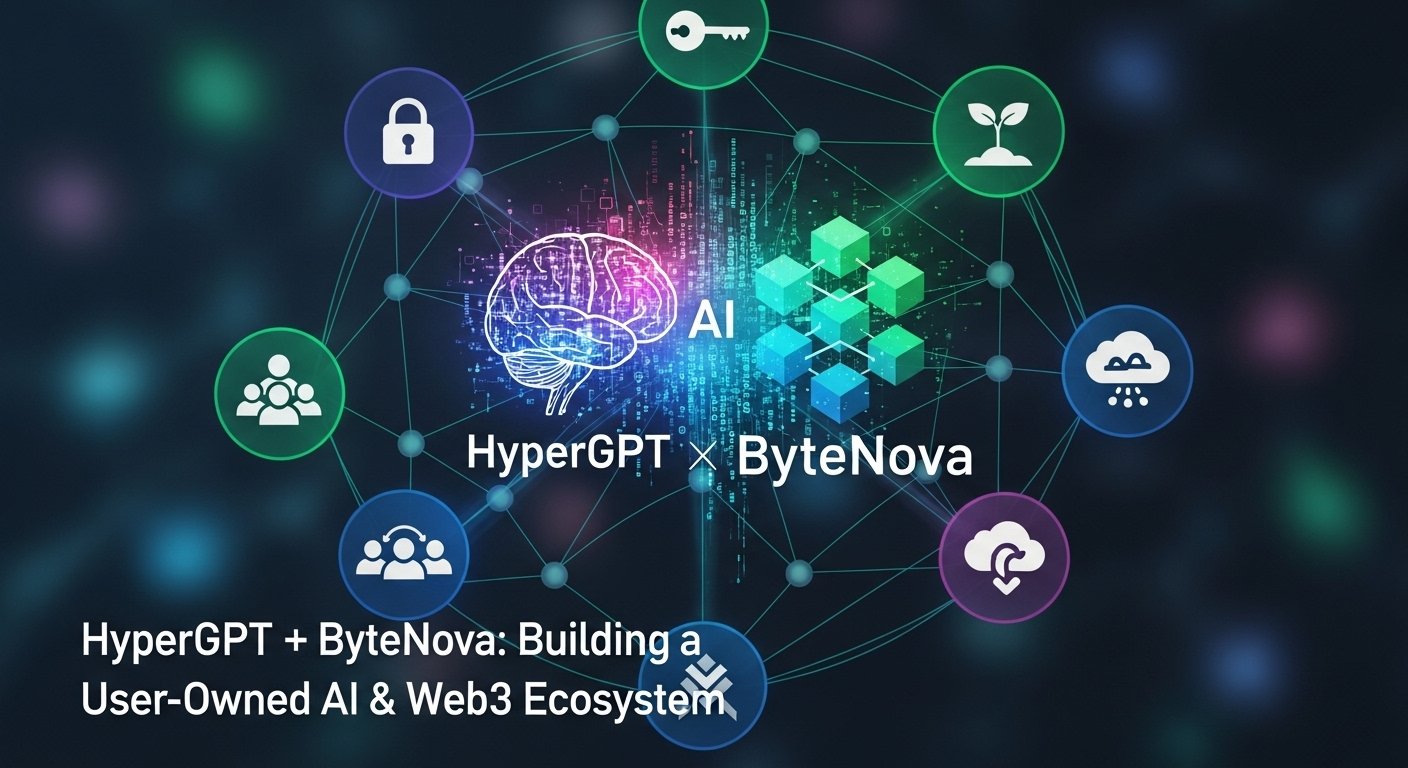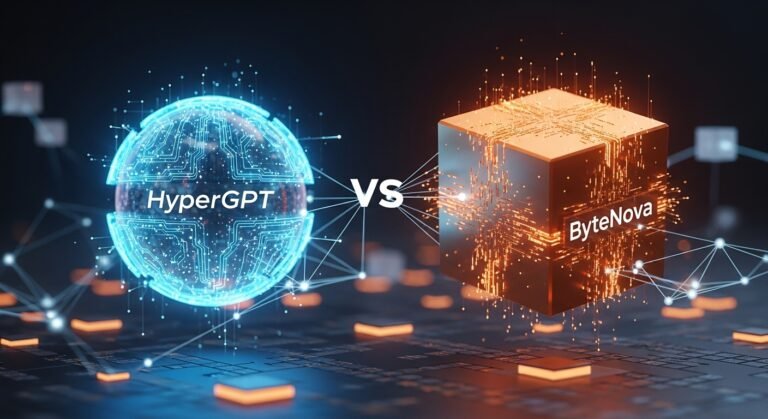HyperGPT and ByteNova positions itself as a next-generation AI marketplace built directly into the Web3 environment. Instead of relying on traditional subscription models or centrally controlled AI platforms, HyperGPT offers a decentralized hub where developers can publish AI agents, users can seamlessly interact with them, and businesses can efficiently integrate AI-driven solutions into their operations. Its marketplace is designed to simplify access to a wide range of AI tools through unified APIs, decentralized payment methods, and permissionless onboarding. HyperGPT and ByteNova structure removes many of the barriers that often prevent smaller developers from competing in the broader AI landscape, enabling them to reach global audiences through an accessible and transparent ecosystem.
HyperGPT also functions as a full-stack AI Web3 ecosystem, where every component, from identity verification to transaction processing, operates through blockchain mechanisms. By integrating Web3 payment systems and smart contracts, HyperGPT ensures that users maintain control over their interactions with AI agents. This is strengthened by the inclusion of decentralized identity systems, which allow users to control the data they share with AI applications through wallet-based authentication rather than revealing personal information. HyperGPT creates a bridge between AI and blockchain, forming a coherent environment where data sovereignty, monetization, and transparency can coexist without the constraints of traditional platforms.
Exploring the Role of ByteNova in the Decentralized AI Landscape
While HyperGPT provides the marketplace and user interface for interacting with AI systems, ByteNova delivers a complementary layer of decentralized infrastructure. ByteNova introduces an edge-first approach to AI computation, focusing on running models locally on devices or geographically distributed nodes instead of depending exclusively on centralized cloud servers. This approach reduces latency and enhances both security and data privacy, as sensitive information can be processed directly on user devices without being sent to large data centers.
ByteNova operates through a decentralized protocol where hardware contributors can supply computational power in exchange for participation rewards. This model turns underutilized hardware across the globe into a powerful distributed AI network, capable of running complex models at a fraction of traditional cloud costs. It enables applications that require real-time processing, such as IoT integrations, autonomous systems, and privacy-sensitive AI workloads, to perform significantly better by keeping computation closer to the source of data. ByteNova’s integration with Web3 principles creates a system where users not only benefit from faster and more private AI responses but can also participate actively in the economic structure that supports the network. This transforms AI infrastructure from a centralized commodity into a shared digital resource, paving the way for a more equitable and efficient ecosystem.
How HyperGPT and ByteNova Build a User-Owned AI and Web3 Ecosystem

The combination of HyperGPT’s marketplace-oriented framework and ByteNova’s decentralized infrastructure creates a powerful model for user-owned AI. HyperGPT enables developers, enterprises, and users to collaborate within a transparent and token-powered marketplace, while ByteNova provides the backend infrastructure that handles computation with higher efficiency, greater privacy, and lower operational costs. The partnership reflects a shift away from traditional AI architectures by enabling applications to operate across decentralized networks while giving users more autonomy.
In this integrated ecosystem, users can interact with AI agents through HyperGPT while enjoying the benefits of ByteNova’s edge-first processing model. This means that AI agents can operate more quickly, respect user privacy, and become part of an environment where all stakeholders—developers, node operators, and end users—share in the value generated by the ecosystem. The integration also allows AI agents to be governed by smart contracts, which adds a layer of trust and transparency to how AI behaves, evolves, and interacts with digital assets. Through token-driven governance and decentralized identity, the combined ecosystem allows users to influence how AI agents operate, vote on upgrades, authorize data access, and contribute to system improvement. This level of inclusion is almost impossible in traditional AI platforms, where decisions are controlled by centralized entities with little to no user input.
The Shift from Centralized AI to User-Owned Intelligence
The partnership between HyperGPT and ByteNova illustrates a shift in how artificial intelligence can be structured in the future. Traditional AI systems rely heavily on massive cloud infrastructures, corporate-managed datasets, and centralized platform control. This model results in limited transparency, potential misuse of data, and restricted innovation. In contrast, a user-owned AI ecosystem encourages transparency, autonomy, and democratization.
A user-owned environment means that individuals maintain direct control over their data. They can decide what information AI agents are allowed to access, how it should be processed, and under what conditions it may be used. The edge-based design of ByteNova ensures that sensitive data can remain local to the user, creating a new standard for privacy-preserving computation. Meanwhile, HyperGPT’s Web3-based infrastructure ensures that ownership rights, economic participation, and governance structures are distributed rather than centralized.Together, the two platforms promote a model where AI behavior becomes increasingly accountable to the people who use it, enhancing trust and reducing the risk of abusive data practices.
Economic Models in a Decentralized AI Marketplace
In a user-owned AI environment, the economic model becomes far more inclusive than traditional SaaS approaches. HyperGPT uses blockchain-based mechanisms to facilitate payments, subscriptions, and access rights in a transparent manner. Developers can monetize their agents directly, without needing to rely on centralized payment processors or platform-specific restrictions. This allows for more creative pricing structures, customized access arrangements, and dynamic monetization that aligns with actual user engagement.
ByteNova adds another economic layer by allowing individuals to supply computational resources to the network. Contributors can earn rewards based on how much they support AI workloads, creating a real incentive for participation. This approach helps decentralize the infrastructure that AI depends on, making it more robust, scalable, and cost-effective. The result is a multi-layered ecosystem where value flows not only to a single corporation but is distributed across developers, users, and compute providers.In this type of economy, AI becomes a shared digital asset with benefits that extend to the entire community rather than being locked behind corporate walls.
Strengthening Privacy, Security, and Transparency

One of the most compelling advantages of combining HyperGPT and ByteNova is the enhanced focus on privacy and security. HyperGPT’s blockchain-based structure ensures that user interactions with AI agents are recorded transparently, while ByteNova’s edge-processing model keeps raw data in the user’s environment. This significantly reduces exposure to data breaches and unauthorized surveillance, as information remains closer to the source and under the user’s control.
Transparency is also substantially improved through smart contracts and decentralized governance. Users can verify how AI systems behave, track how their data is being used, and review the mechanisms through which agents interact with on-chain assets. This combination of transparency and privacy forms a foundation for a more trustworthy AI ecosystem, which is critical as artificial intelligence becomes increasingly integrated into everyday life.
Unlocking Developer Innovation and Business Adoption
The collaborative ecosystem created by HyperGPT and ByteNova provides developers with a sophisticated environment to build AI applications without being constrained by traditional infrastructure limitations. Developers can harness HyperGPT’s marketplace distribution system to reach audiences globally, while ByteNova’s distributed computing model allows them to run AI models with lower latency and at reduced costs. The ability to operate across decentralized networks also encourages experimentation, giving creators the freedom to innovate on new forms of AI agents, Web3 automation tools, and privacy-first applications.
Businesses benefit from predictable and transparent cost structures, as well as the ability to deploy AI systems that align more closely with privacy regulations and internal security policies. The combination of local data processing and transparent marketplace access creates an environment where enterprises can confidently integrate AI tools into their operations.
Challenges Ahead for a User-Owned AI Ecosystem
Despite the promising potential of this combined system, there are challenges that still need to be addressed. User experience remains a critical barrier, as many individuals are not yet comfortable interacting with wallets, smart contracts, or decentralized marketplaces. HyperGPT and ByteNova will need to invest heavily in simplifying interfaces and creating onboarding processes that feel natural to mainstream users.
Regulation is also a major consideration. As governments begin to shape policies around artificial intelligence and data privacy, decentralized ecosystems will need to adapt to new legal frameworks. Navigating compliance while retaining decentralized values will require thoughtful design and constant iteration. Interoperability represents another challenge. A fully decentralized AI ecosystem will require seamless communication among models, chains, identities, and applications. Creating standards for cross-network operations will be an essential part of long-term growth.
Conclusion
HyperGPT and ByteNova represent a powerful shift in how artificial intelligence and Web3 technologies can evolve together. By combining HyperGPT’s marketplace-driven framework with ByteNova’s decentralized edge infrastructure, they create an environment where users gain unprecedented control over data, computation, and AI behavior. This partnership reflects a broader vision for a future where artificial intelligence is not controlled by a handful of corporations but is instead built, governed, and owned collectively.
The roadmap ahead may present challenges, but the potential for transformation is significant. If successful, the collaboration between HyperGPT and ByteNova could reshape how AI is built, how value is shared, and how users engage with intelligent digital systems. For anyone interested in the future of artificial intelligence, blockchain technology, and digital sovereignty, this emerging ecosystem offers a compelling glimpse into what the next generation of the internet may look like.
FAQs
Q: What makes HyperGPT different from traditional AI platforms?
HyperGPT differs from conventional AI platforms because it operates as a decentralized marketplace built on blockchain technology. Instead of relying on centralized servers and subscription models, it enables users to access AI agents through on-chain payments and decentralized identity systems. This creates a more transparent, accessible, and user-centric environment where developers and users share control over how AI tools function.
Q:. How does ByteNova improve AI performance compared to cloud-based systems?
ByteNova improves performance by shifting AI computation toward the edge, meaning tasks are processed on local devices or distributed nodes rather than distant cloud servers. This reduces latency, enhances privacy, and lowers operational costs. Its decentralized structure also increases resilience, making AI workloads less dependent on single points of failure.
Q:.What does user-owned AI mean in this context?
User-owned AI refers to systems where individuals maintain control over their data, how AI models interact with it, and how value generated by AI is distributed. In the HyperGPT and ByteNova ecosystem, users manage permissions through decentralized identity systems, benefit from transparent AI behavior via smart contracts, and can participate in both governance and economic rewards.
Q:. Can developers build their own AI agents on HyperGPT?
Yes, developers can build and publish AI agents directly on HyperGPT’s marketplace. They can monetize their work, interact with a global audience, and deploy applications without needing complex infrastructure. ByteNova’s distributed computing network expands these opportunities by offering efficient, scalable processing for developer-created models.
Q:. Why is combining AI with Web3 technology so important?
The combination of AI and Web3 is important because it introduces transparency, decentralization, and user ownership into a field dominated by centralized control. Web3 ensures that AI systems operate in a fair, accountable, and privacy-conscious manner. When paired with decentralized compute networks like ByteNova and dynamic AI marketplaces like HyperGPT, it creates an entirely new ecosystem for intelligent applications.
Seemore:- Hyperliquid Decentralized Exchange Review 2025 The Future of DeFi Trading


